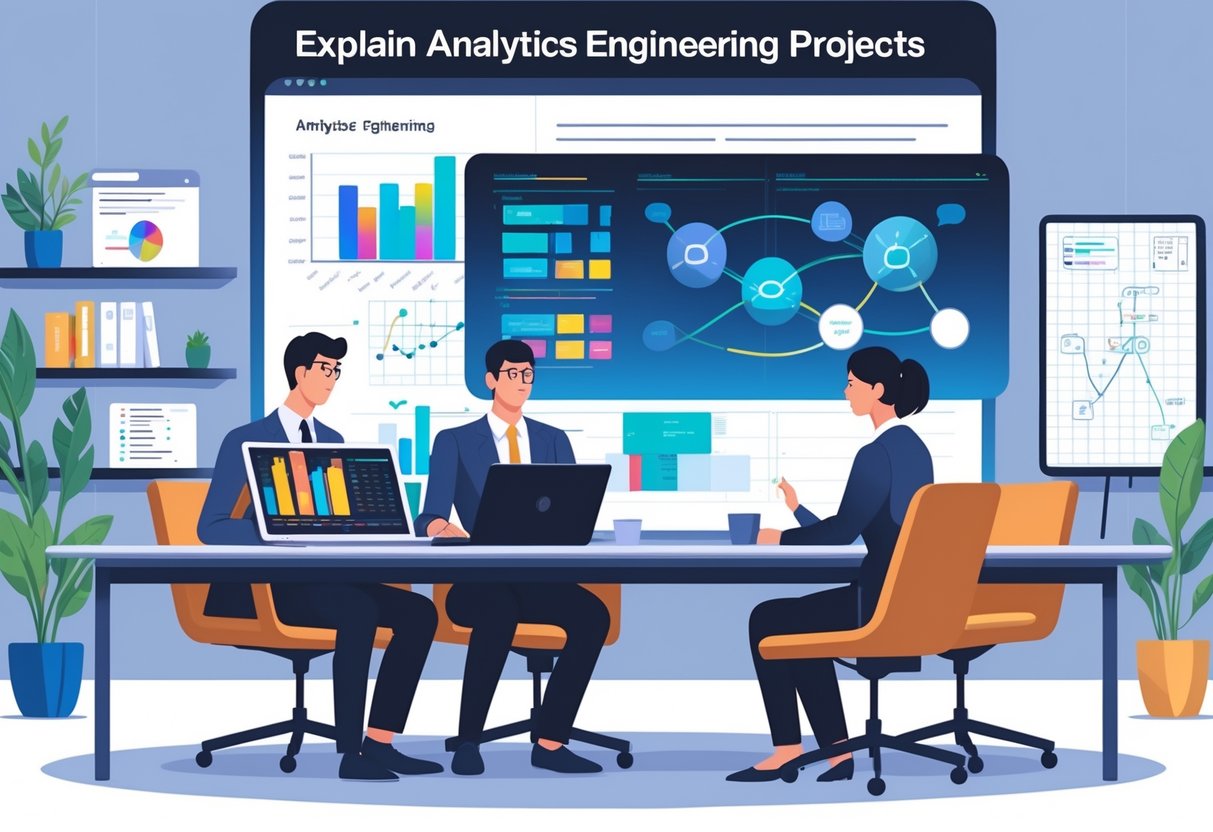Landing an analytics engineering interview means showcasing not just technical skills, but the ability to communicate complex projects clearly and effectively. Many qualified candidates struggle during interviews because they fail to explain their work in a way that demonstrates both their technical expertise and business impact.

The key to successfully explaining analytics engineering projects lies in structuring responses around business problems, technical solutions, and measurable outcomes while adapting communication style to the audience. Analytics engineers must bridge technical and business worlds, making clear communication essential for career advancement.
This comprehensive guide covers how to break down complex data projects into digestible explanations, demonstrate proficiency with relevant tools and methodologies, and prepare for the most common questions interviewers ask. Readers will learn proven frameworks for presenting their work confidently while highlighting the analytical thinking that drives successful business decisions.
Key Takeaways
- Structure project explanations around business problems, technical approaches, and measurable results to show complete understanding
- Demonstrate technical proficiency by explaining specific tools, methodologies, and analytical techniques used in real projects
- Practice answering common analytics engineering questions using clear frameworks that work for both technical and non-technical audiences
Understanding the Core of Analytics Engineering Projects

Before diving into technical details, candidates must establish a clear foundation about their project’s purpose and demonstrate measurable business value. Analytics engineering bridges data and business teams, making it essential to communicate both technical execution and strategic impact.
Defining Your Project’s Objective and Scope
The candidate should start by clearly stating what problem their analytics engineering project solved. They need to explain the specific business challenge or opportunity that drove the project’s creation.
Project scope boundaries help hiring managers understand complexity levels. Candidates should mention:
- Data sources involved (internal databases, APIs, third-party tools)
- Team size and timeline constraints
- Budget or resource limitations
- Technical requirements and constraints
A well-defined scope statement might sound like: “We built a customer behavior analytics pipeline to reduce churn by 15% using data from three different systems over six months.”
The objective should connect directly to business goals. Hiring managers want to see that candidates understand how their technical work supports company strategy.
Candidates should avoid vague descriptions like “improving data quality.” Instead, they should specify measurable goals such as “reducing data processing time from 4 hours to 30 minutes daily.”
Highlighting Business Impact and Outcomes
Quantifiable results demonstrate the candidate’s ability to deliver value beyond technical implementation. They should prepare specific metrics that show project success.
Key impact areas to address include:
- Cost savings or revenue increases
- Time efficiency improvements
- Decision-making speed enhancements
- User adoption rates
- Process automation benefits
For example, a candidate might explain: “The analytics dashboard we created helped sales teams identify high-value prospects 3x faster, resulting in $2M additional quarterly revenue.”
Hiring managers appreciate candidates who track project outcomes after deployment. This shows accountability and business awareness that many technical professionals lack.
The candidate should also mention any unexpected benefits or learnings discovered during the project. This demonstrates adaptability and continuous improvement mindset.
Clarifying Your Role and Contributions
Candidates must distinguish their individual contributions from team achievements. Hiring managers need to understand what specific skills and expertise the candidate brings.
Personal contributions should cover:
- Technical decisions they made independently
- Tools or methodologies they introduced
- Problems they solved without guidance
- Leadership or mentoring responsibilities
They should use action verbs like “designed,” “implemented,” “optimized,” or “led” when describing their work. Passive language weakens the impact of their contributions.
If the project involved data analysis, candidates should specify which analytical techniques they personally applied. They might mention statistical methods, visualization tools, or modeling approaches they selected and executed.
Candidates should also acknowledge team members’ contributions appropriately. This shows collaboration skills while still highlighting their unique value to the project’s success.
Structuring Your Project Explanation

A well-structured explanation helps hiring managers understand complex analytics engineering work quickly. The key is organizing your response around specific challenges you solved and the measurable results you achieved.
Using the STAR Method Effectively
The STAR method provides a structured approach when explaining analytics engineering projects. This framework helps candidates organize their thoughts and deliver clear answers to interview questions.
Situation should describe the business context briefly. The candidate explains what data problems the company faced or what analytics gaps existed.
Task focuses on their specific role and responsibilities. They outline what the hiring manager assigned them to build or improve in the analytics infrastructure.
Action details the technical steps they took. This includes the tools they used, pipelines they built, and data models they created.
Result shows the business impact of their work. They share specific metrics like improved query performance or faster reporting cycles.
The candidate should spend most time on Action and Result sections. These parts demonstrate their technical skills and business impact most clearly.
Focusing on Challenges and Solutions
Analytics engineering projects involve complex technical problems that hiring managers want to understand. Candidates should highlight specific obstacles they overcame during their project work.
Common challenges include:
- Data quality issues like missing values or inconsistent formats
- Performance problems with slow queries or pipeline failures
- Scalability concerns when data volume grew rapidly
- Integration difficulties connecting multiple data sources
For each challenge, they explain their problem-solving approach step by step. They describe how they diagnosed the issue and evaluated different solutions.
The candidate should mention specific tools and techniques they used. This might include dbt for data transformation, Airflow for orchestration, or SQL optimization strategies.
They avoid technical jargon that hiring managers might not understand. Instead, they focus on the logical thinking process behind their solutions.
Integrating Results and Measurable Impact
Hiring managers care most about business outcomes from analytics engineering work. Candidates must translate technical achievements into measurable business value.
Strong results include specific numbers:
- Query performance: “Reduced dashboard load time from 45 seconds to 8 seconds”
- Data freshness: “Improved data pipeline frequency from daily to hourly updates”
- Cost savings: “Decreased cloud computing costs by 30% through query optimization”
- User adoption: “Enabled 200+ business users to access self-service analytics”
They explain how these improvements affected daily operations. For example, faster dashboards helped sales teams make quicker decisions during client meetings.
The candidate connects their technical work to broader business goals. They show how better data infrastructure supported revenue growth or operational efficiency.
They prepare backup metrics in case the hiring manager asks follow-up questions. This demonstrates thorough understanding of their project’s impact across different areas of the business.
Demonstrating Technical Skills and Tools

Analytics engineers must clearly articulate their proficiency with specific programming languages and data processing tools. Interviewers expect concrete examples of how candidates applied Python for automation, Excel for analysis, and various techniques for extracting insights from complex datasets.
Showcasing Data Analysis Techniques
Candidates should describe their systematic approach to analyzing information and solving problems with specific methodologies. They need to explain techniques like statistical analysis, data visualization, and pattern recognition through real project examples.
Key techniques to highlight:
- Exploratory data analysis (EDA)
- Statistical modeling and hypothesis testing
- Data cleaning and validation processes
- Trend analysis and forecasting
The candidate should walk through a specific project where they identified data quality issues. They might explain how they detected outliers using standard deviation calculations or found missing values that affected results.
Visualization examples work well during interviews. They can describe creating dashboards that revealed customer behavior patterns or sales trends that influenced business decisions.
Explaining Use of Python in Projects
Programming languages like Python form the backbone of most analytics engineering work. Candidates must demonstrate hands-on experience with relevant libraries and frameworks.
Essential Python tools to mention:
- pandas for data manipulation
- numpy for numerical computations
- matplotlib/seaborn for visualization
- scikit-learn for machine learning
They should describe automating repetitive tasks with Python scripts. For example, they might explain building an ETL pipeline that processed daily sales data from multiple sources.
Specific code examples strengthen their explanation. They could mention writing functions to clean customer data or creating algorithms that flagged unusual transaction patterns.
The candidate should emphasize problem-solving abilities. They might describe debugging complex data processing systems or optimizing slow-running scripts to handle larger datasets efficiently.
Utilizing Excel for Data Processing
Excel remains crucial for many analytics tasks despite advanced programming tools. Candidates should demonstrate proficiency with advanced functions and data analysis features.
Advanced Excel skills include:
- Pivot tables for data summarization
- VLOOKUP and INDEX-MATCH functions
- Power Query for data transformation
- Conditional formatting for pattern identification
They should explain using Excel for initial data exploration before moving to more sophisticated tools. Many stakeholders prefer Excel reports because they can easily modify and share them.
The candidate might describe creating financial models or budget forecasts using Excel formulas. They could mention building interactive dashboards with slicers and charts that executives used for monthly reviews.
They should acknowledge Excel’s limitations while highlighting its strengths. Excel works well for smaller datasets and quick analysis but requires Python or SQL for larger, more complex data processing tasks.
Communicating Analytical Approaches and Methodologies

Explaining technical methods clearly demonstrates expertise while showing how analytical work creates business value. Candidates must translate complex processes into understandable language that highlights their problem-solving abilities.
Articulating Regression Analysis and Statistical Methods
Candidates should explain regression analysis using concrete examples from their projects. They can describe how they used linear regression to predict sales trends or logistic regression to classify customer segments.
The explanation should focus on the business problem first. For example, “The company needed to understand which factors drove customer churn, so I built a logistic regression model using customer behavior data.”
Key elements to communicate:
- Why they chose specific statistical methods
- How they validated model accuracy
- What the results meant for business decisions
Candidates should avoid technical jargon when describing statistical concepts. Instead of saying “R-squared was 0.85,” they can explain “The model explained 85% of the variation in sales, making it reliable for forecasting.”
They should mention how they handled common issues like multicollinearity or overfitting. This shows depth of knowledge without overwhelming the interviewer with technical details.
Describing Data Cleaning and Preparation
Data preparation often consumes 80% of analytics projects, making it crucial to explain this process clearly. Candidates should describe specific cleaning challenges they encountered and how they solved them.
Common data issues to discuss:
- Missing values and imputation strategies
- Duplicate records and deduplication methods
- Outliers and how they handled them
- Data type inconsistencies
They should explain their decision-making process. For instance, “I found 15% missing values in the income field, so I used median imputation because the data was skewed.”
Candidates can mention tools they used like Python pandas or SQL for data manipulation. They should emphasize how proper data preparation improved model performance or analysis accuracy.
The explanation should connect data quality to business outcomes. Poor data leads to wrong conclusions, so thorough preparation ensures reliable insights.
Detailing Reporting and Visualization Strategies
Effective communication of analytical findings requires matching the presentation to the audience. Technical teams need different details than executive stakeholders.
Candidates should describe how they chose visualization types. Bar charts work well for comparisons, while line graphs show trends over time. They should explain why they selected specific chart types for their data.
Visualization best practices to mention:
- Using clear titles and labels
- Choosing appropriate color schemes
- Avoiding cluttered displays
- Highlighting key insights
They should discuss how they structured reports or presentations. Starting with key findings keeps audiences engaged before diving into methodology details.
Interactive dashboards allow users to explore data themselves. Candidates can describe how they built dashboards using tools like Tableau or Power BI to enable self-service analytics.
The focus should remain on making complex data analysis accessible to non-technical audiences while maintaining accuracy and completeness.
Preparing for Common Interview Questions

Successfully explaining analytics engineering projects requires preparation for three distinct question categories. Candidates must anticipate technical deep-dives, handle unexpected queries gracefully, and connect their work to business outcomes.
Anticipating Project-Specific Inquiries
Analytics engineers should expect detailed questions about their specific project implementations. Common analytics engineer interview questions often focus on technical architecture and decision-making processes.
Candidates must prepare to explain their data pipeline design choices. They should articulate why they selected specific tools like dbt, Airflow, or Snowflake for their projects. The hiring manager wants to understand the reasoning behind technical decisions.
Key areas to prepare include:
- Data modeling approaches and schema design
- ETL/ELT pipeline architecture
- Testing and validation strategies
- Performance optimization techniques
They should practice explaining complex transformations in simple terms. Mock interviews help candidates refine their explanations and identify knowledge gaps before the actual interview.
Responding to Unexpected Technical Questions
Even well-prepared candidates encounter surprising technical questions during interviews. Staying calm and composed when faced with unfamiliar topics demonstrates professional maturity.
When candidates don’t know an answer, honesty works better than guessing. They should acknowledge the knowledge gap while explaining their approach to finding solutions. This shows problem-solving methodology rather than just memorized facts.
Effective response strategies include:
- Breaking down complex questions into smaller components
- Drawing parallels to familiar concepts or technologies
- Explaining the thought process for approaching unknown problems
- Demonstrating willingness to research and learn
Candidates can redirect conversations toward their strengths. If asked about an unfamiliar tool, they might discuss similar technologies they’ve used successfully.
Addressing Business and Behavioral Questions
Analytics engineering interviews extend beyond technical skills. Hiring managers evaluate how candidates connect data work to business outcomes and collaborate with stakeholders.
Candidates should prepare examples of translating business requirements into technical solutions. They need stories about working with non-technical teams and explaining complex analytics concepts to various audiences.
Essential behavioral topics include:
- Handling conflicting stakeholder requirements
- Managing project timelines and deliverables
- Communicating data quality issues to leadership
- Collaborating across engineering and business teams
They should quantify their project impacts whenever possible. Specific metrics like “reduced report generation time by 75%” or “improved data accuracy from 85% to 99%” demonstrate tangible value delivery.
The STAR method helps structure responses effectively. Candidates describe the Situation, Task, Action, and Result for each example they share during the interview.
Frequently Asked Questions

Interviewers often focus on specific aspects of analytics engineering experience to gauge technical expertise and problem-solving abilities. These questions typically center on project impact, data modeling approaches, quality assurance methods, requirement translation skills, performance optimization, and continuous learning practices.
Can you walk me through a past analytics engineering project you worked on and the impact it had on the business?
Candidates should prepare to discuss a project where they used data and analytics to drive decisions with clear business outcomes. The response should follow a structured approach that covers the problem, solution, and measurable results.
Start with the business challenge or opportunity that prompted the project. Explain the specific pain points or questions the organization needed to address.
Describe the technical approach taken, including tools used and methodologies applied. Focus on the candidate’s specific contributions rather than general team efforts.
Highlight the measurable business impact achieved. Include specific metrics like cost savings, revenue increases, or efficiency improvements whenever possible.
Discuss any challenges encountered and how they were overcome. This demonstrates problem-solving skills and adaptability.
How do you approach the data modeling phase in analytics engineering, and could you explain the tools and methodologies you’ve used?
Data modeling methodology should demonstrate understanding of business requirements and translation into scalable data structures. Candidates need to show familiarity with dimensional modeling techniques and modern tools.
Begin by explaining the process of gathering and understanding business requirements. This involves working with stakeholders to identify key metrics and reporting needs.
Describe the approach to schema design, whether using star schema, snowflake schema, or other modeling techniques. Explain the reasoning behind choosing specific approaches.
Mention specific tools used for data modeling such as dbt, Looker, or traditional data warehouse platforms. Include experience with version control and documentation practices.
Discuss how the data model supports both current needs and future scalability. Address considerations for data governance and maintenance.
How do you ensure the quality and reliability of data in the pipelines you develop?
Data quality management requires systematic approaches including validation techniques, error handling, and monitoring systems. Candidates should demonstrate knowledge of testing frameworks and anomaly detection methods.
Explain the implementation of automated data quality checks throughout the ETL process. This includes validation at extraction, transformation, and loading stages.
Describe specific testing frameworks used, such as dbt tests or custom validation scripts. Include examples of the types of tests implemented.
Discuss monitoring and alerting systems that notify teams of data anomalies or pipeline failures. Mention tools like Datadog or custom monitoring solutions.
Address data lineage tracking and documentation practices that help maintain data reliability over time. Include version control and change management processes.
What are the key considerations when translating business requirements into technical specifications for analytics projects?
Successful requirement translation involves understanding business context, identifying technical constraints, and designing scalable solutions. This process requires strong communication skills and technical expertise.
Start by explaining the importance of thorough stakeholder interviews and requirement gathering sessions. Emphasize active listening and asking clarifying questions.
Describe the process of breaking down complex business questions into specific data requirements. Include identifying necessary data sources and transformation logic.
Discuss technical considerations such as data availability, processing constraints, and performance requirements. Address how these factors influence design decisions.
Explain the documentation and validation process to ensure alignment between business needs and technical implementation. Include feedback loops and iteration cycles.
Could you discuss a time when you had to optimize an analytics engineering process for better performance or scalability?
Performance optimization demonstrates problem-solving skills and understanding of database systems. Candidates should provide specific examples with measurable improvements.
Describe the performance issue encountered, including specific symptoms like slow query execution or system bottlenecks. Provide context about the impact on users or business processes.
Explain the diagnostic process used to identify the root cause. This might include analyzing execution plans, monitoring system resources, or reviewing data architecture.
Detail the specific optimization techniques applied, such as indexing strategies, query rewriting, or infrastructure changes. Include the reasoning behind chosen solutions.
Quantify the results achieved through optimization efforts. Provide specific metrics like percentage improvements in execution time or resource utilization.
How do you stay updated with the latest developments and technologies in analytics engineering and apply them in your work?
Continuous learning is essential in the rapidly evolving field of analytics engineering. Candidates should demonstrate commitment to professional development and practical application of new knowledge.
Describe specific resources used for staying current, such as reputable industry publications, conferences, or online courses from well-established platforms. For hands-on practice and skill-building, explore Analytics Engineering’s practice exercises and quizzes. Participation in professional communities or forums, such as those hosted by Kaggle or Stack Overflow, can also be valuable.
Explain the process for evaluating new technologies or methodologies before implementing them in production environments. This should include consideration of stability, compatibility, and business value. You may find it helpful to review premium projects that demonstrate real-world application and evaluation of new tools.
Provide examples of recently adopted technologies or techniques and their impact on work quality or efficiency. Show how learning translates into practical improvements. For example, leveraging resources like Analytics Engineering’s games selection can help reinforce new concepts through interactive learning.
Discuss knowledge sharing practices within teams or organizations. Include mentoring, documentation, or presentation activities that help others benefit from new insights. Internal documentation and regular team presentations, along with collaborative exercises such as those found on Analytics Engineering, can foster a culture of continuous improvement.

